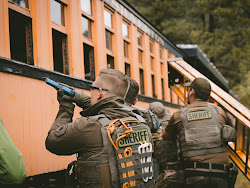 Less-lethal devices are devices that are increasingly being used by US law enforcement to cause as few casualties as possible, including death. Less-lethal and de-escalation devices include a wide range of devices like the traditional police baton, tear gas, and pepper spray. As well as electric-shock weapons such as Tasers™, water cannons, and acoustic weapons or rubber and plastic projectiles.
Less-lethal devices are devices that are increasingly being used by US law enforcement to cause as few casualties as possible, including death. Less-lethal and de-escalation devices include a wide range of devices like the traditional police baton, tear gas, and pepper spray. As well as electric-shock weapons such as Tasers™, water cannons, and acoustic weapons or rubber and plastic projectiles.
The Importance of Less Lethal Training
Violent interactions between law enforcement and civilians have resulted in casualties on both sides. Using less lethal training platforms like those from T4E Guns can help prevent this.
Leveraging less lethal equipment in training scenarios for Law Enforcement and Military officers enhances the officer's ability and adaptability for reaction time and problem-solving due to the realistic feel and function of the training pistols and training rifles offered by T4E.
Less-lethal platforms are also used in policing and public order situations where the use of lethal force is prohibited. The military also occasionally needs to employ less-lethal technology where situations require the fewest casualties or conventional force is restricted.
Moreover, the use of non-lethal devices or platforms has proven to be very successful during demonstrations or peacekeeping operations. It is also very effective in controlling riots, domestic crowds, or, in some cases, prisoners.
It can often be used for individual self-defense.
Types of Less Lethal De-escalation Devices
Rubber Bullets
Rubber bullets were originally developed in the 1960s by the British Ministry of Defense and are now very popular among police and military forces for riot control and dispersing crowds.
Although they are called "rubber bullets," they're not solely made out of rubber. In fact, it has a metal core with just a rubber coating around it and is fired at very low speeds. Rubber has also largely been replaced by other materials, such as soft polymers, plastic, and wax.
Tear Gas
Tear gas is a very common method used in riots to control the crowd. It is usually launched by means of a grenade. One variety of tear gas is pepper spray, which temporarily irritates and blinds the eyes as well as inflames the nose, throat, and skin. It is used many times to bring a rowdy crowd or a suspect under control.
Although law enforcement authorities and even military personnel use tear gas for domestic riot control, its use in warfare is forbidden.
Water Cannons
Modern water cannons are also capable of adding tear gas to the water.
Tasers
The Taser is an electroshock device that was initially developed for use by police. The Taser fires thin, wire-like projectiles that give a sudden electric shock, which disrupts the superficial muscle functions of the body. Stun guns and stun batons are also somewhat similar, but they administer an electric shock through direct contact. Tasers are now also widely used within the US military as well.
The logic behind using less-lethal training is to prepare first responders for real-world situations to reduce the instances of fatalities and injuries that are inflicted by law enforcement officials.
